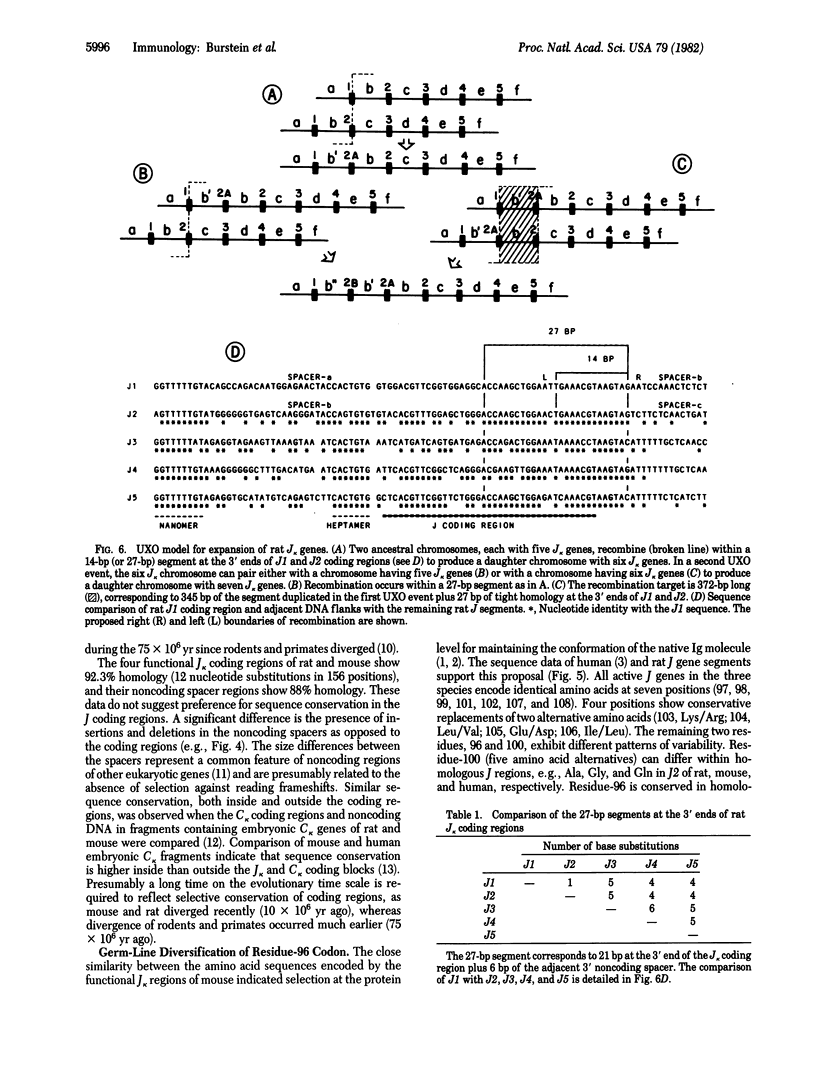Abstract
Sequence determination of the joining segment gene (J) cluster in the kappa chain (J kappa) in the embryonic context demonstrates that rat genome contains seven J kappa gene segments that expanded from an ancestral cluster of five J kappa genes. The rat J segments are separated by about 300 base pairs (bp) and are flanked 5' by the presumed variable region (V)/J recombination signal sequence and 3' by the RNA splicing signal. Two of the J gene segments designated J2A and J2B and their 5'-flanking spacer DNA bear striking homology to J2 and its 5'-flanking spacer. Thus, the unit of duplication was the entire J kappa coding region and 5' noncoding spacer (345 bp). The duplication probably occurred as two separate unequal crossing-over (UXO) events. The first UXO event can be confined to recombination within an identical stretch (14 bp long) located at the 3' ends of the coding regions of J1 and J2. The second event could involve a longer segment (372 bp) of tight homology generated by the first UXO event, thus increasing the probability of repeated expansion of the same DNA segment. The sequence homology among the rat duplicated segments (98-99%) is larger than the homology between the corresponding rat and mouse segments (89%), showing that the rat J kappa gene expansion must have occurred after rat and mouse divergence 10 X 10(6) yr ago. We estimate that the first and second UXO events occurred 2 X 10(6) and 1 X 10(6) yr ago, respectively. J3 of rat and mouse share the same mutation (G leads to C) in the RNA splicing signal that presumably inactivates J3. This mutation preceded divergence of the two species. A mutation in the first nucleotide of codon 96 has occurred in both duplicated segments, the only position along 345 bp where J2, J2A, and J2B differ from each other. This results in three different amino acids at position 96 not present in any other J kappa. These mutations are physiologically significant because they diversify the third complementarity-determining region (CDR3) and, thus, may reflect selective pressure to increase antibody diversity. The germ-line diversification of CDR3 was exercised within the last 1-2 X 10(6) yr.
Full text
PDF




Selected References
These references are in PubMed. This may not be the complete list of references from this article.
- Breiner A. V., Brandt C. R., Milcarek C., Sweet R. W., Ziv E., Burstein Y., Schechter I. Somatic DNA rearrangement generates functional rat immunoglobulin kappa chain genes: the J kappa gene cluster is longer in rat than in mouse. Gene. 1982 May;18(2):165–174. doi: 10.1016/0378-1119(82)90114-7. [DOI] [PubMed] [Google Scholar]
- Hieter P. A., Maizel J. V., Jr, Leder P. Evolution of human immunoglobulin kappa J region genes. J Biol Chem. 1982 Feb 10;257(3):1516–1522. [PubMed] [Google Scholar]
- Hieter P. A., Max E. E., Seidman J. G., Maizel J. V., Jr, Leder P. Cloned human and mouse kappa immunoglobulin constant and J region genes conserve homology in functional segments. Cell. 1980 Nov;22(1 Pt 1):197–207. doi: 10.1016/0092-8674(80)90168-3. [DOI] [PubMed] [Google Scholar]
- Höchtl J., Müller C. R., Zachau H. G. Recombined flanks of the variable and joining segments of immunoglobulin genes. Proc Natl Acad Sci U S A. 1982 Mar;79(5):1383–1387. doi: 10.1073/pnas.79.5.1383. [DOI] [PMC free article] [PubMed] [Google Scholar]
- Jeffreys A. J., Harris S. Processes of gene duplication. Nature. 1982 Mar 4;296(5852):9–10. doi: 10.1038/296009a0. [DOI] [PubMed] [Google Scholar]
- Max E. E., Maizel J. V., Jr, Leder P. The nucleotide sequence of a 5.5-kilobase DNA segment containing the mouse kappa immunoglobulin J and C region genes. J Biol Chem. 1981 May 25;256(10):5116–5120. [PubMed] [Google Scholar]
- Max E. E., Seidman J. G., Leder P. Sequences of five potential recombination sites encoded close to an immunoglobulin kappa constant region gene. Proc Natl Acad Sci U S A. 1979 Jul;76(7):3450–3454. doi: 10.1073/pnas.76.7.3450. [DOI] [PMC free article] [PubMed] [Google Scholar]
- Maxam A. M., Gilbert W. Sequencing end-labeled DNA with base-specific chemical cleavages. Methods Enzymol. 1980;65(1):499–560. doi: 10.1016/s0076-6879(80)65059-9. [DOI] [PubMed] [Google Scholar]
- Mount S. M. A catalogue of splice junction sequences. Nucleic Acids Res. 1982 Jan 22;10(2):459–472. doi: 10.1093/nar/10.2.459. [DOI] [PMC free article] [PubMed] [Google Scholar]
- Nishioka Y., Leder P. The complete sequence of a chromosomal mouse alpha--globin gene reveals elements conserved throughout vertebrate evolution. Cell. 1979 Nov;18(3):875–882. doi: 10.1016/0092-8674(79)90139-9. [DOI] [PubMed] [Google Scholar]
- Obata M., Kataoka T., Nakai S., Yamagishi H., Takahashi N., Yamawaki-Kataoka Y., Nikaido T., Shimizu A., Honjo T. Structure of a rearranged gamma 1 chain gene and its implication to immunoglobulin class-switch mechanism. Proc Natl Acad Sci U S A. 1981 Apr;78(4):2437–2441. doi: 10.1073/pnas.78.4.2437. [DOI] [PMC free article] [PubMed] [Google Scholar]
- Ravetch J. V., Siebenlist U., Korsmeyer S., Waldmann T., Leder P. Structure of the human immunoglobulin mu locus: characterization of embryonic and rearranged J and D genes. Cell. 1981 Dec;27(3 Pt 2):583–591. doi: 10.1016/0092-8674(81)90400-1. [DOI] [PubMed] [Google Scholar]
- Sakano H., Hüppi K., Heinrich G., Tonegawa S. Sequences at the somatic recombination sites of immunoglobulin light-chain genes. Nature. 1979 Jul 26;280(5720):288–294. doi: 10.1038/280288a0. [DOI] [PubMed] [Google Scholar]
- Sheppard H. W., Gutman G. A. Allelic forms of rat kappa chain genes: evidence for strong selection at the level of nucleotide sequence. Proc Natl Acad Sci U S A. 1981 Nov;78(11):7064–7068. doi: 10.1073/pnas.78.11.7064. [DOI] [PMC free article] [PubMed] [Google Scholar]
- Starace V., Querinjean P. The primary structure of a rat kappa Bence Jones protein: phylogenetic relationships of V- and C-region genes. J Immunol. 1975 Jul;115(1):59–62. [PubMed] [Google Scholar]
- Van Ness B. G., Coleclough C., Perry R. P., Weigert M. DNA between variable and joining gene segments of immunoglobulin kappa light chain is frequently retained in cells that rearrange the kappa locus. Proc Natl Acad Sci U S A. 1982 Jan;79(2):262–266. doi: 10.1073/pnas.79.2.262. [DOI] [PMC free article] [PubMed] [Google Scholar]
- Zeelon E. P., Bothwell A. L., Kantor F., Schechter I. An experimental approach to enumerate the genes coding for immunoglobulin variable-regions. Nucleic Acids Res. 1981 Aug 11;9(15):3809–3820. doi: 10.1093/nar/9.15.3809. [DOI] [PMC free article] [PubMed] [Google Scholar]


